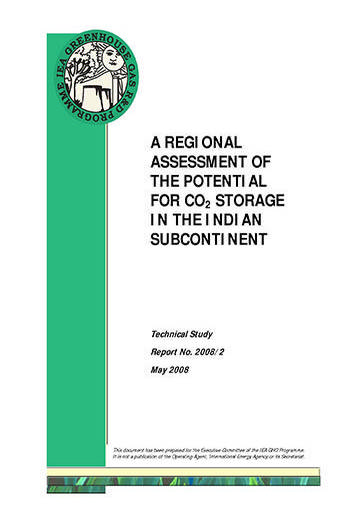Publications
A regional assessment of the potential for CO2 storage in the Indian subcontinent
12th May 2008
Topic(s): Carbon capture use and storage (CCUS), CO2 storage
The IEA Greenhouse Gas R&D Programme (IEA GHG) has recently commissioned the British Geological Society (BGS) to conduct a regional assessment of the Indian subcontinent in order to gauge the potential for CO2 storage in geological reservoirs in that region. This is the 3rd regional capacity study conducted by the IEA GHG following on from assessments of Europe and North America. It should be noted that the study only assessed the four main options of geological storage; deep saline aquifers, depleted oil and gas fields, and storage in deep unminable coal fields. In addition, the study has undertaken an assessment of the current large point source emissions from the power sector on the Indian subcontinent and assessed their geographical relationship with possible geological stores. This process is also known as sourcestore matching, and a good source of CO2 close to suitable geological storage reservoirs can significantly impact on the costs and technical feasibility of a CCS operation. Without nearby sources for injection, the transport element of the CO2 chain becomes more expensive, and thus can result in the classification of a proposal as uneconomical.
The choice of the Indian subcontinent for this third study is primarily down to two main reasons. Firstly, as an emergent economy, India is considered likely to experience high growth in energy demand due to increasing economic development, and this will naturally include a corresponding increase in anthropogenic CO2 emissions. Much of the increased power demand will come from increased use of fossil fuels and in particular coal. The growth in energy demand is likely to be met by government backed plans to install increased capacity in power plants throughout many regions. History has taught us that when a country undergoes rapid economic growth, there is a corresponding increase in the demand for power and subsequent increase in anthropogenic CO2 emissions. The second driver behind the choice the Indian subcontinent is the current lack of any other definitive study into the capacity for CCS in the area.
Disclaimer
The content within the Global CCS Institute Publications, Reports and Research Library is provided for information purposes only. We make every effort and take reasonable care to keep the content of this section up-to-date and error-free. However, we make no claim as to its accuracy, currency or reliability.
Content and material featured within this section of our website includes reports and research published by third parties. The content and material may include opinions and recommendations of third parties that do not reflect those held by the Global CCS Institute.
